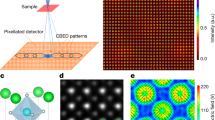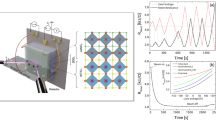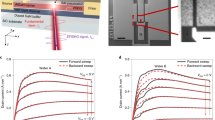Abstract
Mobile charge carriers are essential components in high-performance, nano-engineered semiconductor devices. Employing charge carriers confined to heterointerfaces, the so-called two-dimensional electron gas, is essential for improving device performance. The real-space visualization of a two-dimensional electron gas at the nanometre scale is desirable. However, it is challenging to accomplish by means of electron microscopy due to an unavoidable strong diffraction contrast formation at the heterointerfaces. We performed direct, nanoscale electric field imaging across a GaN-based semiconductor heterointerface using differential phase contrast scanning transmission electron microscopy by suppressing diffraction contrasts. For both nearly the lattice-matched GaN/Al0.81In0.19N interface and pseudomorphic GaN/Al0.88In0.12N interface, the extracted quantitative electric field profiles show excellent agreement with profiles predicted using Poisson simulation. Furthermore, we used the electric field profiles to quantify the density and distribution of the two-dimensional electron gas across the heterointerfaces with nanometre precision. This study is expected to guide the real-space characterization of local charge carrier density and distribution in semiconductor devices.
This is a preview of subscription content, access via your institution
Access options
Access Nature and 54 other Nature Portfolio journals
Get Nature+, our best-value online-access subscription
$29.99 / 30 days
cancel any time
Subscribe to this journal
Receive 12 print issues and online access
$259.00 per year
only $21.58 per issue
Buy this article
- Purchase on Springer Link
- Instant access to full article PDF
Prices may be subject to local taxes which are calculated during checkout




Similar content being viewed by others
Data availability
The data supporting the findings of this study are available within the paper. The DPC, HAADF and EDS images are available on the GitHub repository (https://github.com/sigma-users/GaNAlInNdata).
References
Ambacher, O. et al. Two dimensional electron gases induced by spontaneous and piezoelectric polarization in undoped and doped AlGaN/GaN heterostructures. J. Appl. Phys. 87, 334–344 (2000).
Ambacher, O. et al. Two-dimensional electron gases induced by spontaneous and piezoelectric polarization charges in N- and Ga-face AlGaN/GaN heterostructures. J. Appl. Phys. 85, 3222–3233 (1999).
Ohta, H. et al. Giant thermoelectric Seebeck coefficient of a two-dimensional electron gas in SrTiO3. Nat. Mater. 6, 129–134 (2007).
Ferain, I., Colinge, C. A. & Colinge, J.-P. Multigate transistors as the future of classical metal–oxide–semiconductor field-effect transistors. Nature 479, 310–316 (2011).
Syaranamual, G. J. et al. Role of two-dimensional electron gas (2DEG) in AlGaN/GaN high electron mobility transistor (HEMT) ON-state degradation. Microelectron. Reliab. 64, 589–593 (2016).
Kaushik, P. K., Singh, S. K., Gupta, A., Basu, A. & Chang, E. Y. Impact of surface states and aluminum mole fraction on surface potential and 2DEG in AlGaN/GaN HEMTs. Nanoscale Res. Lett. 16, 159 (2021).
Smorchkova, I. P. et al. Polarization-induced charge and electron mobility in AlGaN/GaN heterostructures grown by plasma-assisted molecular-beam epitaxy. J. Appl. Phys. 86, 4520–4526 (1999).
Ibbetson, J. P. et al. Polarization effects, surface states, and the source of electrons in AlGaN/GaN heterostructure field effect transistors. Appl. Phys. Lett. 77, 250–252 (2000).
Zheng, Z. et al. Gallium nitride-based complementary logic integrated circuits. Nat. Electron. 4, 595–603 (2021).
Joh, J. & del Alamo, J. A. A current-transient methodology for trap analysis for GaN high electron mobility transistors. IEEE Trans. Electron Devices 58, 132–140 (2011).
Pearton, S. J., Ren, F., Patrick, E., Law, M. E. & Polyakov, A. Y. Review—ionizing radiation damage effects on GaN devices. ECS J. Solid State Sci. Technol. 5, Q35–Q60 (2016).
Nakagami, K., Ohno, Y., Kishimoto, S., Maezawa, K. & Mizutani, T. Surface potential measurements of AlGaN/GaN high-electron-mobility transistors by Kelvin probe force microscopy. Appl. Phys. Lett. 85, 6028–6029 (2004).
Masuda, H., Ishida, N., Ogata, Y., Ito, D. & Fujita, D. Internal potential mapping of charged solid-state-lithium ion batteries using in situ Kelvin probe force microscopy. Nanoscale 9, 893–898 (2017).
Cao, Y., Pomeroy, J. W., Uren, M. J., Yang, F. & Kuball, M. Electric field mapping of wide-bandgap semiconductor devices at a submicrometre resolution. Nat. Electron. 4, 478–485 (2021).
Shibata, N. et al. Differential phase-contrast microscopy at atomic resolution. Nat. Phys. 8, 611–615 (2012).
Müller-Caspary, K. et al. Electrical polarization in AlN/GaN nanodisks measured by momentum-resolved 4D scanning transmission electron microscopy. Phys. Rev. Lett. 122, 106102 (2019).
Song, K. et al. Direct imaging of the electron liquid at oxide interfaces. Nat. Nanotechnol. 13, 198–203 (2018).
Wolf, D. et al. Unveiling the three-dimensional magnetic texture of skyrmion tubes. Nat. Nanotechnol. 17, 250–255 (2022).
Mawson, T. et al. Suppressing dynamical diffraction artefacts in differential phase contrast scanning transmission electron microscopy of long-range electromagnetic fields via precession. Ultramicroscopy 219, 113097 (2020).
Haas, B., Rouvière, J.-L., Boureau, V., Berthier, R. & Cooper, D. Direct comparison of off-axis holography and differential phase contrast for the mapping of electric fields in semiconductors by transmission electron microscopy. Ultramicroscopy 198, 58–72 (2019).
Yamamoto, K., Anada, S., Sato, T., Yoshimoto, N. & Hirayama, T. Phase-shifting electron holography for accurate measurement of potential distributions in organic and inorganic semiconductors. Microscopy 70, 24–38 (2021).
Marino, F. A., Cullen, D. A., Smith, D. J., McCartney, M. R. & Saraniti, M. Simulation of polarization charge on AlGaN/GaN high electron mobility transistors: comparison to electron holography. J. Appl. Phys. 107, 054516 (2010).
Wu, Z. H. et al. Mapping the electrostatic potential across AlGaN/AlN/GaN heterostructures using electron holography. Appl. Phys. Lett. 90, 032101 (2007).
Kohno, Y., Nakamura, A., Morishita, S. & Shibata, N. Development of tilt-scan system for differential phase contrast scanning transmission electron microscopy. Microscopy 71, 111–116 (2022).
Toyama, S. et al. Quantitative electric field mapping in semiconductor heterostructures via tilt-scan averaged DPC STEM. Ultramicroscopy 238, 113538 (2022).
Lippmann, B. A. Ehrenfest’s theorem and scattering theory. Phys. Rev. Lett. 15, 11–14 (1965).
Close, R., Chen, Z., Shibata, N. & Findlay, S. D. Towards quantitative, atomic-resolution reconstruction of the electrostatic potential via differential phase contrast using electrons. Ultramicroscopy 159, 124–137 (2015).
Seki, T. et al. Quantitative electric field mapping in thin specimens using a segmented detector: revisiting the transfer function for differential phase contrast. Ultramicroscopy 182, 258–263 (2017).
Kohno, Y., Seki, T., Findlay, S. D., Ikuhara, Y. & Shibata, N. Real-space visualization of intrinsic magnetic fields of an antiferromagnet. Nature 602, 234–239 (2022).
Sánchez-Santolino, G. et al. Probing the internal atomic charge density distributions in real space. ACS Nano 12, 8875–8881 (2018).
Ishikawa, R. et al. Direct electric field imaging of graphene defects. Nat. Commun. 9, 3878 (2018).
Gao, W. et al. Real-space charge-density imaging with sub-ångström resolution by four-dimensional electron microscopy. Nature 575, 480–484 (2019).
Trellakis, A. et al. The 3D nanometer device project nextnano: concepts, methods, results. J. Comput. Electron. 5, 285–289 (2006).
Birner, S. et al. nextnano: general purpose 3-D simulations. IEEE Trans. Electron Devices 54, 2137–2142 (2007).
Schowalter, M., Rosenauer, A., Lamoen, D., Kruse, P. & Gerthsen, D. Ab initio computation of the mean inner Coulomb potential of wurtzite-type semiconductors and gold. Appl. Phys. Lett. 88, 232108 (2006).
Jain, S. C., Willander, M., Narayan, J. & Overstraeten, R. V. III–Nitrides: growth, characterization, and properties. J. Appl. Phys. 87, 965–1006 (2000).
Ando, T., Fowler, A. B. & Stern, F. Electronic properties of two-dimensional systems. Rev. Mod. Phys. 54, 437–672 (1982).
Ando, T. Self-consistent results for a GaAs/AlxGa1–xAs heterojunciton. II. Low temperature mobility. J. Phys. Soc. Jpn 51, 3900–3907 (1982).
Quang, D. N., Tuoc, V. N., Tung, N. H., Minh, N. V. & Phong, P. N. Roughness-induced mechanisms for electron scattering in wurtzite group-III-nitride heterostructures. Phys. Rev. B 72, 245303 (2005).
Quang, D. N. et al. Quantum and transport lifetimes due to roughness-induced scattering of a two-dimensional electron gas in wurtzite group-III-nitride heterostructures. Phys. Rev. B 74, 205312 (2006).
Kawahara, K. et al. Unique fitting of electrochemical impedance spectra by random walk Metropolis Hastings algorithm. J. Power Sources 403, 184–191 (2018).
Butté, R. et al. Current status of AlInN layers lattice-matched to GaN for photonics and electronics. J. Phys. D 40, 6328–6344 (2007).
Crespo, A. et al. High-power Ka-band performance of AlInN/GaN HEMT with 9.8-nm-thin barrier. IEEE Electron Device Lett. 31, 2–4 (2010).
Py, M. A., Lugani, L., Taniyasu, Y., Carlin, J.-F. & Grandjean, N. Shallow donor and deep DX-like center in InAlN layers nearly lattice-matched to GaN. Phys. Rev. B 90, 115208 (2014).
Kappers, M. J., Zhu, T., Sahonta, S. ‐L., Humphreys, C. J. & Oliver, R. A. SCM and SIMS investigations of unintentional doping in III‐nitrides. Phys. Status Solidi C 12, 403–407 (2015).
Chung, R. B. et al. Growth study and impurity characterization of AlxIn1−xN grown by metal organic chemical vapor deposition. J. Cryst. Growth 324, 163–167 (2011).
Egerton, R. F. Electron Energy-Loss Spectroscopy in the Electron Microscope (Springer Science & Business Media, 2011).
Shibata, N. et al. Atomic resolution electron microscopy in a magnetic field free environment. Nat. Commun. 10, 2308 (2019).
Morishita, S. et al. Attainment of 40.5 pm spatial resolution using 300 kV scanning transmission electron microscope equipped with fifth-order aberration corrector. Microscopy 67, 46–50 (2018).
Tsuda, K. & Tanaka, M. Refinement of crystal structural parameters using two-dimensional energy-filtered CBED patterns. Acta Crystallogr. A 55, 939–954 (1999).
Acknowledgements
This work was supported by JST ERATO, grant number JPMJER2202, Japan. A part of this work was supported by JSPS KAKENHI, grant numbers JP20H05659 and JP19H05788. S. Toyama acknowledges support from a Grant-in-Aid for JSPS Research Fellow, grant number JP20J21517. T.S. acknowledges support from JST-PRESTO, grant number JPMJPR21AA; JSPS KAKENHI, grant number JP20K15014; and the Kazato Research Foundation. A part of this work was supported by the Advanced Research Infrastructure for Materials and Nanotechnology, grant number JPMXP1222UT0044, sponsored by the Ministry of Education, Culture, Sports, Science and Technology, Japan.
Author information
Authors and Affiliations
Contributions
S. Toyama, T.S. and N.S. designed the study and wrote the paper. S. Toyama performed the STEM experiments, simulation and image analysis. Y. Kanitani fabricated the transmission electron microscopy samples. Y. Kudo, S. Tomiya and Y.I. contributed to the discussion and comments. N.S. directed the entire study.
Corresponding authors
Ethics declarations
Competing interests
The authors declare no competing interests.
Peer review
Peer review information
Nature Nanotechnology thanks the anonymous reviewers for their contribution to the peer review of this work.
Additional information
Publisher’s note Springer Nature remains neutral with regard to jurisdictional claims in published maps and institutional affiliations.
Extended data
Extended Data Fig. 1 Differential phase contrast (DPC) and tilt-scan-averaged DPC (tDPC) images of the GaN/AlInN heterointerfaces.
a–d, Horizontal and vertical electric field component images, electric field vector color map, and charge density map of the GaN/Al0.81In0.19N (LM-AlInN) sample obtained via tDPC observation along the \(\left[ {{{{\mathrm{11}}}}{\bar{2}}0} \right]\) zone axis. e–h, Horizontal and vertical electric field component images, electric field vector color map, and charge density map of the GaN/ LM-AlInN sample obtained via conventional DPC observation along the \(\left[ {{{{\mathrm{11}}}}{\bar{2}}0} \right]\) zone axis (without tilt averaging). i–l, Horizontal and vertical electric field component images, electric field vector color map and charge density map obtained of the GaN/ LM-AlInN sample via DPC observation along the \(\left[ {1{\bar{1}}{{{\mathrm{00}}}}} \right]\) zone axis (without tilt averaging). m–p, Horizontal and vertical electric field component images, electric field vector color map, and charge density map obtained of the GaN/Al0.88In0.12N (PM-AlInN) sample via DPC observation along the \(\left[ {1{\bar{1}}{{{\mathrm{00}}}}} \right]\) zone axis (without tilt averaging). All scale bars correspond to 20 nm.
Extended Data Fig. 2 Differential phase contrast (DPC) and tilt-scan-averaged DPC (tDPC) profiles.
a, b, Horizontal electric field and charge density profiles of the GaN/Al0.81In0.19N (LM-AlInN) sample obtained via tDPC observation along the \(\left[ {{{{\mathrm{11}}}}{\bar{2}}0} \right]\) zone axis. c, d, Horizontal electric field and charge density profiles of the GaN/ LM-AlInN sample obtained via DPC observation along the \(\left[ {1{\bar{1}}{{{\mathrm{20}}}}} \right]\) zone axis (without tilt averaging). e, f, Horizontal electric field and charge density profiles of the GaN/LM-AlInN sample obtained via DPC observation along the \(\left[ {1{\bar{1}}{{{\mathrm{00}}}}} \right]\) zone axis (without tilt averaging). g, h, Horizontal electric field and charge density profiles of the GaN/Al0.88In0.12N (PM-AlInN) sample obtained via DPC observation along the \(\left[ {1{\bar{1}}{{{\mathrm{00}}}}} \right]\) zone axis (without tilt averaging).
Extended Data Fig. 3 Structure observation of the GaN/PM-AlInN heterostructure.
a, Atomic-resolution high-angle annular dark field STEM image of the GaN/PM-AlInN heterointerface. b, c, d, Indium, Gallium, and Aluminum energy dispersive X-ray spectroscopy elemental maps of the GaN/PM-AlInN heterointerface.
Extended Data Fig. 5 Detector and bright field (BF) disk configuration.
a, Configuration of the bright field disk (green circle) relative to the 40-segmented detector. b, 61-beam-tilt pattern acquired with the detilt coils off. In the actual experiment, these patterns converged into a single BF disk on the detector plane by the detilt coils on.
Extended Data Fig. 6 Simulated results of the tilt averaged BF disks.
a, b Simulated electron channeling patterns of [1-100] and [11–20] incident beam directions with 100 nm sample thickness. The center of the patterns corresponds to the exact zone axis. c, d, 61-beam-tilt patterns extracted from a and b under the experimental conditions of tDPC STEM. e, f, The averaged bright-field disks of the beam-tilt patterns shown in c and d, respectively. a and b, c and d, e and f are set to be the same intensity scales, respectively.
Extended Data Fig. 7 Simulated electric field profiles without high-density n-type donors in the AlInN layers.
a, Simulated electric field profile of GaN/Al0.81In0.19N (LM-AlInN) with n-type donors of 1 × 1016 e/cm−3 in the entire film. b, Simulated electric field profile of GaN/Al0.88In0.12N (PM-AlInN) with n-type donors of 1 × 1016 e/cm−3 in the entire film. c, d, Simulated charge density profiles of the GaN/ LM-AlInN and GaN/PM-AlInN heterointerfaces generated by calculating the divergence of a and b, respectively.
Extended Data Fig. 8 Fitting results of the experimental electric field profiles.
a, Electric field profile of the GaN/Al0.81In0.19N (LM-AlInN) sample along the \(\left[ {1{\bar{1}}{{{\mathrm{00}}}}} \right]\) zone axis by tDPC STEM (blue cross mark) and fitting result based on the Fang-Howard wave function using the Markov chain Monte Carlo optimization (orange line). b, Electric field profile of the GaN/Al0.88In0.12N (PM-AlInN) sample along the \(\left[ {1{\bar{1}}{{{\mathrm{00}}}}} \right]\) zone axis by tDPC STEM (blue crosses) and fitting result based on the same method (orange line).
Rights and permissions
Springer Nature or its licensor (e.g. a society or other partner) holds exclusive rights to this article under a publishing agreement with the author(s) or other rightsholder(s); author self-archiving of the accepted manuscript version of this article is solely governed by the terms of such publishing agreement and applicable law.
About this article
Cite this article
Toyama, S., Seki, T., Kanitani, Y. et al. Real-space observation of a two-dimensional electron gas at semiconductor heterointerfaces. Nat. Nanotechnol. 18, 521–528 (2023). https://doi.org/10.1038/s41565-023-01349-8
Received:
Accepted:
Published:
Issue Date:
DOI: https://doi.org/10.1038/s41565-023-01349-8
This article is cited by
-
Atomic-level polarization in electric fields of defects for electrocatalysis
Nature Communications (2023)



